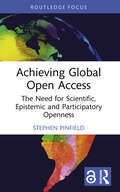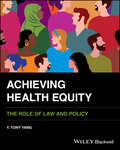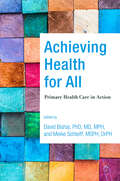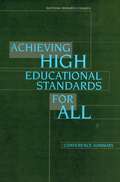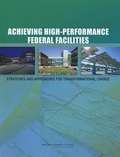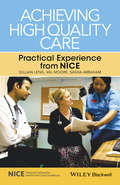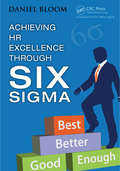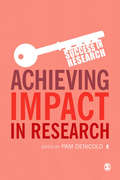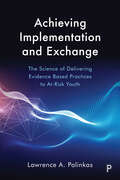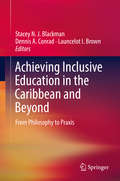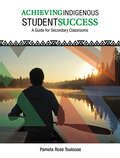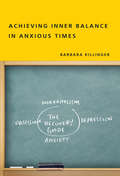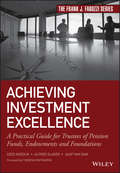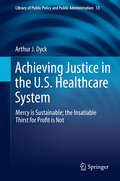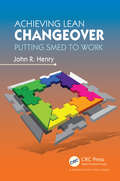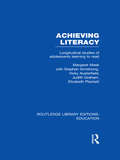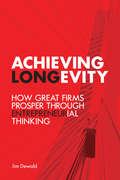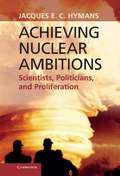- Table View
- List View
Achieving Global Open Access: The Need for Scientific, Epistemic and Participatory Openness (Routledge Critical Studies on Open Access)
by Stephen PinfieldAchieving Global Open Access explores some of the key conditions that are necessary to deliver global Open Access (OA) that is effective and equitable.Often assumed to be a self-evident good, OA has been subject to growing criticism for perpetuating global inequities and epistemic injustices. It has been seen as imposing exploitative business and publishing models and as exacerbating exclusionary research evaluation cultures and practices. Pinfield engages with these issues, recognising that the global OA debate is now not just about publishing business models and academic reward structures, but also about what constitutes valid and valuable knowledge, how we know, and who gets to say. The book argues that, for OA to deliver its potential, it first needs to be associated with ‘epistemic openness’, a wider and more inclusive understanding of what constitutes valid and valuable knowledge. It also needs to be accompanied by ‘participatory openness’, enabling contributions to knowledge from more diverse communities. Interacting with relevant theory and current practice, the book discusses the challenges in implementing these different forms of openness, the relationships between them, and their limits.Achieving Global Open Access is essential reading for academics and students engaged in the study of Library and Information Science, Open Access and Publishing. It will also be valuable and interesting to library and publishing professionals around the world.
Achieving Health Equity: The Role of Law and Policy
by Y. Tony YangUnveiling the Path to Health Equity: A Transformative Guide to Law and Policy Achieving Health Equity: The Role of Law and Policy offers a groundbreaking exploration of how legal and policy frameworks shape health outcomes for marginalized populations, with a particular focus on racial minorities in the United States. This comprehensive guide dissects the complex interplay of factors determining health: 20% healthcare, 30% health behaviors, 40% social and economic factors, and 10% physical environment. Amid the backdrop of the COVID-19 pandemic and a national reckoning on racism, this timely work provides an urgent call to action and a practical roadmap for transformative change. It examines how laws and policies across sectors intersect to perpetuate or dismantle health inequities, offering concrete strategies for reform. Key features include: An ecosystem approach exploring four critical domains: healthcare access and quality, health behaviors, social and economic factors, and physical environment Analysis of emerging issues such as addressing the impact of climate change on health disparities, strategies for mitigating algorithmic bias in healthcare AI, and promoting equity in organ transplantation and clinical trials Examination of cross-cutting themes like community engagement, civil rights protections, and data disaggregation to guide targeted interventions Case studies and policy tools for dismantling structural drivers of health inequity Written in accessible language without sacrificing depth, this book illuminates complex concepts through relatable examples. It serves as an invaluable resource for a diverse audience including health system administrators implementing diversity, equity, and inclusion initiatives, public health officials and policymakers, legal professionals and advocates, researchers and students in health-related fields, community organizers and racial justice activists. Achieving Health Equity provides a comprehensive blueprint for leveraging law and policy to build a more just, equitable, and healthy future for all.
Achieving Health Equity via the Affordable Care Act: Workshop Summary
by Karen M. AndersonSince its creation by the Institute of Medicine (IOM) in 2007, the Roundtable on the Promotion of Health Equity and the Elimination of Health Disparities has been fostering dialogue on racial and ethnic disparities in health and health care, examining the development of programs and strategies to reduce disparities, and encouraging the emergence of new leadership focused on health equity. For the past several years, a prominent topic of discussion within the roundtable has been the Patient Protection and Affordable Care Act (ACA). The ACA has multiple provisions specific to race, ethnicity, and language and other provisions with significant implications for racially and ethnically diverse populations. In April 2013, the roundtable held a workshop to address many issues surrounding the ACA, including expansion of coverage, delivery systems, and access points, service delivery and payment reform, public-private partnerships, and challenges to the safety net. This report summarizes the presentations and discussions from the workshop.
Achieving Health for All: Primary Health Care in Action
by David Bishai, PhD, MD, MPH and Meike Schleiff, MSPH, DrPHHow did seven low- and middle-income countries, inspired by the landmark Alma-Ata Declaration, dramatically improve citizen health by focusing on primary health care?The Alma-Ata Declaration of 1978 marked a potential turning point in global health, signaling a commitment to primary health care that could have improved the safety of air, food, water, roads, homes, and workplaces in all 180 countries that signed it. Unfortunately, progress in many countries stalled in the 1980s. The declaration was, however, embraced by a number of countries, where its implementation led to substantial improvement in citizen health. Achieving Health for All reveals how, inspired by Alma-Ata, the governments of seven countries executed comprehensive primary health care systems, deploying new cadres of community-based health workers to bring relevant services to ordinary households. Drawing on a set of narrative case studies from Bangladesh, Indonesia, Ethiopia, Nepal, Ghana, Sri Lanka, and Vietnam,the book explains how a primary health care focus succeeded in improving population health. The book also conclusively demonstrates that comprehensive, multisector, community-controlled, and population-level primary health care is a viable strategy that, against the odds, has led to sustainable, scalable good health at lower cost. Bringing together a group of experts to analyze the forty-year legacy of the Alma-Ata Declaration, Achieving Health for All is a fascinating look at the work needed to transform nations from places that make people sick to places where they stay healthy. An inspiring array of lessons learned along the way shows how readers can make policies that support the health of all people.Contributors: Onaopemipo Abiodun, Vinya Ariyaratne, John Koku Awoonor-Williams, Kedar Prasad Baral, Ayaga A. Bawah, Pedro Más Bermejo, Fred N. Binka, David Bishai, Carolina Cardona, Dennis Carlson, Chala Tesfaye Chekagn, Hoang Khanh Chi, Svea Closser, Luc Barrière Constantin, Zufan Abera Damtew, Marlou de Rouw, Nadia Diamond-Smith, Philip Forth, Mignote Solomon Haile, Nguyen Thanh Huong, Taufique Joarder, Alice Kuan, Seblewengel Lemma, Sasmira Matta, Ahmed Moen, Rituu B. Nanda, Frank K. Nyonator, Ferdous Arfina Osman, Claudia Pereira, Henry B. Perry, James F. Phillips, Meike Schleiff, Melissa Sherry, Rita Thapa, Kebede Worku
Achieving High Educational Standards for All: Conference Summary
by Timothy Ready Catherine E. Snow Christopher F. EdleyThis volume summarizes a range of scientific perspectives on the important goal of achieving high educational standards for all students. Based on a conference held at the request of the U.S. Department of Education, it addresses three questions: What progress has been made in advancing the education of minority and disadvantaged students since the historic Brown v. Board of Education decision nearly 50 years ago? What does research say about the reasons of successes and failures? What are some of the strategies and practices that hold the promise of producing continued improvements? The volume draws on the conclusions of a number of important recent NRC reports, including How People Learn, Preventing Reading Difficulties in Young Children, Eager to Learn, and From Neurons to Neighborhoods, among others. It includes an overview of the conference presentations and discussions, the perspectives of the two co-moderators, and a set of background papers on more detailed issues.
Achieving High-Performance Federal Facilities: Strategies and Approaches for Transformational Change
by Committee on High-Performance Green Federal Buildings: Strategies Approaches for Meeting Federal ObjectivesThe design, construction, operation, and retrofit of buildings is evolving in response to ever-increasing knowledge about the impact of indoor environments on people and the impact of buildings on the environment. Research has shown that the quality of indoor environments can affect the health, safety, and productivity of the people who occupy them. Buildings are also resource intensive, accounting for 40 percent of primary energy use in the United States, 12 percent of water consumption, and 60 percent of all non-industrial waste. The processes for producing electricity at power plants and delivering it for use in buildings account for 40 percent of U. S. greenhouse gas emissions. The U. S. federal government manages approximately 429,000 buildings of many types with a total square footage of 3. 34 billion worldwide, of which about 80 percent is owned space. More than 30 individual departments and agencies are responsible for managing these buildings. The characteristics of each agency's portfolio of facilities are determined by its mission and its programs. In 2010, GSA's Office of Federal High-Performance Green Buildings asked the National Academies to appoint an ad hoc committee of experts to conduct a public workshop and prepare a report that identified strategies and approaches for achieving a range of objectives associated with high-performance green federal buildings. Achieving High-Performance Federal Facilities identifies examples of important initiatives taking place and available resources. The report explores how these examples could be used to help make sustainability the preferred choice at all levels of decision making. Achieving High-Performance Federal Facilities can serve as a valuable guide federal agencies with differing missions, types of facilities, and operating procedures.
Achieving High Quality Care
by Gillian Leng Val Moore Sasha AbrahamDrawing on the experience of the National Institute for Health and Care Excellence (NICE), Achieving High Quality Care is a practical guide on how to recognise and implement high quality evidence and guidance.This new title provides an overview of the evidence behind successful initiatives designed to change practice and improve the quality of health care. It provides an overall picture of change management, from understanding the barriers to change to how these barriers can best be overcome. It presents a concise summary of the evidence for change, plus examples of specific initiatives drawn from experience of putting NICE guidance into practice.The book includes a wide range of examples of positive change - plus key practical points highlighted throughout the text - to help readers achieve improvements in patient care. Finally, it shows how to measure change, assess improvement to agreed standards and to manage the ongoing process of change towards improving health care.Achieving High Quality Care is a helpful guide for busy health care professionals wanting to improve services and patient care. It is relevant to everyone involved in the organisation and provision of quality health care, including clinicians and health care managers, who are trying to lead change and improve care through implementing evidence-based guidance.
Achieving HR Excellence through Six Sigma
by Daniel BloomAlthough world-class firms like GE and Motorola have relied on Six Sigma to build their performance cultures, these processes are all too often left out of human resources (HR) functions. This lack of Six Sigma principles is even more surprising because preventing errors and improving productivity are so critical to the people management processes
Achieving HR Excellence through Six Sigma
by Daniel T. BloomAlthough world-class firms like GE and Motorola have relied on Six Sigma to build their performance cultures, these processes are all too often left out of human resources (HR) functions. This lack of Six Sigma principles is even more surprising because preventing errors and improving productivity are so critical to the people management processes of hiring, retention, appraisal, and development. From the history and evolution of the Total Quality movement to initiatives for introducing a Six Sigma continuous process improvement strategy in your HR department, Achieving HR Excellence through Six Sigma, Second Edition introduces a new way to envision your role within the organization. It explains how this powerful methodology works and supplies a roadmap to help you find and eliminate waste in your HR processes. Describing exactly what HR excellence means, the book outlines dozens of proven approaches as well as a hierarchy of the exact steps required to achieve it. It illustrates the Six Sigma methodology from the creation of a project to its successful completion. At each stage, it describes the specific tools currently available and provides examples of organizations that have used Six Sigma within HR to improve their organizations. The text presents proven approaches that can help you solve and even eliminate people management problems altogether. Filled with real-world examples, it demonstrates how to implement Six Sigma into the transformational side of your organization. It also includes a listing of additional resources to help you along your Six Sigma journey. Explaining how to build a new business model for your HR organization, the book supplies the new perspective and broad view you will need to discover and recommend game-changing alternatives to traditional HR approaches in your organization. The first edition of this book was one of the first to demonstrate how HR professionals could enhance their careers by learning the language of business — it introduced the evolution of change management and the change management toolbox in a fashion that could easily be implemented in organizations. This new edition updates the first with added information on some of the early history and introduces new case study tools resulting from the author’s continuing work with organizations and in academic environments.
Achieving Human Rights
by Richard FalkRichard Falk once again captures our attention with a nuanced analysis of what we need to do - at the personal level as well as state actions - to refocus our pursuit of human rights in a post-9/11 world. From democratic global governance, to the costs of the Iraq War, the preeminent role of the United States in the world order to the role of individual citizens of a globalized world, Falk stresses the moral urgency of achieving human rights. In elegant simplicity, this book places the priority of such an ethos in the personal decisions we make in our human interactions, not just the activities of government institutions and non-governmental organizations. Falk masterly weaves together such topics as the Iraq War, U.S. human rights practices and abuses, humanitarian intervention, the rule of law, responses to terrorism, genocide in Bosnia, the Pinochet trial, the Holocaust, and information technology to create a moral tapestry of world order with human rights at the center.
Achieving Impact in Research (Success in Research)
by Pam DenicoloThis unique addition to the Success in Research series addresses the importance of understanding and achieving impact for the purposes of gaining research funding and reporting achieved impact for the Research Excellence Framework (REF). The book includes contributions from researchers and researcher developers who feel that impact is ill-defined and poorly understood despite its prevalence in policy documents, websites and institutional activities. This succinct and cohesive text draws on the expert contributors' collective research practice, knowledge and experience. Using a variety of examples, boxed activities and highlighted reflection points, this practical guide covers the following key areas: - The meaning of impact in relation to research - How the Impact Agenda fits with attitudes and ethics that motivate research - The different characterisations of research impact and when impact is apparent - How impact can be planned into proposals, evaluated and evidenced - The skills needed to be an impactful researcher - How impact can be supported through Knowledge Exchange and effective partnerships This is a must-have guide for anyone seeking to understand and achieve impact in their own research.
Achieving Implementation and Exchange: The Science of Delivering Evidence-Based Practices to At-Risk Youth
by Lawrence A. PalinkasConverting research evidence into practice is an issue of growing importance to many fields of policy and practice worldwide. This book, by a leading implementation specialist in child welfare and mental health, addresses the frustrating gap between research conducted on effective practices and the lack of routine use of such practices. Drawing on implementation science, the author introduces a model for reducing the gap between research and practice. This model highlights the roles of social networks, research evidence, practitioner/policymaker decision-making, research-practice-policy partnerships, and cultural exchanges between researchers and practitioners and policymakers. He concludes with a discussion of how the model may be used to develop more widespread use of evidence-based practices for the prevention and treatment of behavioural and mental health problems in youth-serving systems of care, as well as partnerships that promote ongoing quality improvement in services delivery.
Achieving Inclusive Education in the Caribbean and Beyond: From Philosophy to Praxis
by Stacey N. Blackman Dennis A. Conrad Launcelot I. BrownThis book offers an international perspective of philosophical, conceptual and praxis-oriented issues that impinge on achieving education for all students. It sheds light on the historical, systemic, structural, organizational, and attitudinal barriers that continue to be antithetical to the philosophy and practice of inclusive education within the Caribbean. The first section of the book examines how globalized views of inclusion informed by philosophical ideas from the North have influenced and continue to influence the equity in education agenda in the region. The second section considers how exclusion and marginalization still occur across selected Caribbean islands. It provides both quantitative and qualitative data about the nature and experience of exclusion in selected Caribbean islands, the UK and USA. The third section tackles the practical realities of transforming education systems in the Caribbean for inclusion. In particular, it identifies teacher practices as the main site of interrogation that needs to be tackled if inclusion is to be successful. The fourth and final section examines the contribution of principals and exemplars to the development and advocacy for inclusive education. It discusses how educational leadership is understood, as well as the role of school principals in making inclusion a reality in schools, the challenges experienced and the qualities of education leaders.
Achieving Indigenous Student Success: A Guide for Secondary Classrooms
by Pamela Rose ToulouseIn Achieving Indigenous Student Success, author Pamela Toulouse provides strategies, lessons, and hands-on activities that support both Indigenous and non-Indigenous learners in the secondary classroom. Read chapters on topics such as:Indigenous Pedagogy and Classrooms ConsiderationsIndigenous Self-Esteem and Mental Health ActivitiesDifferentiated Instruction and Bloom's TaxonomyAttrition, Retention, Transition, and Graduation ContinuumIndigenous Themes and Material ResourcesCulturally Appropriate Secondary Lesson Plans by Subject (including English, Math, Science, History, Geography, Health, Physical Education, Drama, Music, Visual Arts, Technological Studies, Business Studies, Indigenous Worldviews, Guidance and Career Studies, and Social Studies and the Humanities)This book is for all teachers of grades 9–12 who are looking for ways to infuse Indigenous perspectives into their courses. Ideas include best practices for retention/transition/graduation planning, differentiated instruction, assessment, and equity instruction. Using appropriate themes for curricular connections, the author presents a culturally relevant and holistic approach that helps to build bridges between cultures and fosters self-esteem in all students.
Achieving Indigenous Student Success: A Guide for Secondary Classrooms
by Pamela Rose ToulouseIn Achieving Indigenous Student Success, author Pamela Toulouse provides strategies, lessons, and hands-on activities that support both Indigenous and non-Indigenous learners in the secondary classroom. Read chapters on topics such as:Indigenous Pedagogy and Classrooms ConsiderationsIndigenous Self-Esteem and Mental Health ActivitiesDifferentiated Instruction and Bloom's TaxonomyAttrition, Retention, Transition, and Graduation ContinuumIndigenous Themes and Material ResourcesCulturally Appropriate Secondary Lesson Plans by Subject (including English, Math, Science, History, Geography, Health, Physical Education, Drama, Music, Visual Arts, Technological Studies, Business Studies, Indigenous Worldviews, Guidance and Career Studies, and Social Studies and the Humanities)This book is for all teachers of grades 9–12 who are looking for ways to infuse Indigenous perspectives into their courses. Ideas include best practices for retention/transition/graduation planning, differentiated instruction, assessment, and equity instruction. Using appropriate themes for curricular connections, the author presents a culturally relevant and holistic approach that helps to build bridges between cultures and fosters self-esteem in all students.
Achieving Indigenous Student Success: A Guide for Secondary Classrooms
by Pamela Rose ToulouseIn Achieving Indigenous Student Success, author Pamela Toulouse provides strategies, lessons, and hands-on activities that support both Indigenous and non-Indigenous learners in the secondary classroom. Read chapters on topics such as:Indigenous Pedagogy and Classrooms ConsiderationsIndigenous Self-Esteem and Mental Health ActivitiesDifferentiated Instruction and Bloom's TaxonomyAttrition, Retention, Transition, and Graduation ContinuumIndigenous Themes and Material ResourcesCulturally Appropriate Secondary Lesson Plans by Subject (including English, Math, Science, History, Geography, Health, Physical Education, Drama, Music, Visual Arts, Technological Studies, Business Studies, Indigenous Worldviews, Guidance and Career Studies, and Social Studies and the Humanities)This book is for all teachers of grades 9–12 who are looking for ways to infuse Indigenous perspectives into their courses. Ideas include best practices for retention/transition/graduation planning, differentiated instruction, assessment, and equity instruction. Using appropriate themes for curricular connections, the author presents a culturally relevant and holistic approach that helps to build bridges between cultures and fosters self-esteem in all students.
Achieving Inner Balance in Anxious Times
by Barbara KillingerClinical psychologist Dr Barbara Killinger offers insights and a variety of techniques that she developed in working with her clients over the years. Through their stories, she illustrates the dynamics of workaholism, showing how it produces profound personality changes, negatively affects family interactions, and reduces effectiveness at work. She explains the dynamics of how workaholism can result in the loss of personal and professional integrity, and why ambitious, perfectionistic people typically become obsessive and increasingly narcissistic. Achieving Inner Balance in Anxious Times shows us how to become aware of the darker side of our personalities, and how to avoid conflict and power struggles by establishing clear ego boundaries that help build mutual trust and respect in our personal and professional lives. The achievement of inner balance makes work-life balance possible.
Achieving Inner Balance in Anxious Times
by Barbara KillingerClinical psychologist Dr Barbara Killinger offers insights and a variety of techniques that she developed in working with her clients over the years. Through their stories, she illustrates the dynamics of workaholism, showing how it produces profound personality changes, negatively affects family interactions, and reduces effectiveness at work. She explains the dynamics of how workaholism can result in the loss of personal and professional integrity, and why ambitious, perfectionistic people typically become obsessive and increasingly narcissistic. Achieving Inner Balance in Anxious Times shows us how to become aware of the darker side of our personalities, and how to avoid conflict and power struggles by establishing clear ego boundaries that help build mutual trust and respect in our personal and professional lives. The achievement of inner balance makes work-life balance possible.
Achieving Investment Excellence: A Practical Guide for Trustees of Pension Funds, Endowments and Foundations (Frank J. Fabozzi Series)
by Kees Koedijk Alfred Slager Jaap Van DamAchieving Investment Excellence offers trustees and asset managers a comprehensive handbook for improving the quality of their investments. With a stated goal of substantially and sustainably improving annual returns, this book clarifies and demystifies important concepts surrounding trustee duties and responsibilities, investment strategies, analysis, evaluation and much more. Low interest rates are making the high cost of future pension payouts fraught with tension, even as the time and knowledge required to manage these funds appropriately increases — it is no wonder that pensions are increasingly seen as a financial liability. Now more than ever, it is critical that trustees understand exactly what contributes to investment success — and what detracts from it. This book details the roles, the tools and the strategies that make pension funds pay off. Achieving Investment Excellence provides the expert insight, clear guidance and key wisdom you need to manage these funds successfully.
Achieving Justice in the U.S. Healthcare System: Mercy is Sustainable; the Insatiable Thirst for Profit is Not (Library of Public Policy and Public Administration #13)
by Arthur J. DyckThis book focuses on justice and its demands in the way of providing people with medical care. Building on recent insights on the nature of moral perceptions and motivations from the neurosciences, it makes a case for the traditional medical ethic and examines its financial feasibility. The book starts out by giving an account of the concept of justice and tracing it back to the practices and tenets of Hippocrates and his followers, while taking into account findings from the neurosciences. Next, it considers whether the claim that it is just to limit medical care for everyone to some basic minimum is justifiable. The book then addresses finances and expenditures of the US health care system and shows that the growth of expenditures and the percentage of the gross national product spent on health care make for an unsustainable trajectory. In light of the question what should be changed, the book suggests that overdiagnosis and medicalizing normal behavior lead to harmful, costly and unnecessary interventions and are the result of unethical behavior on the part of the pharmaceutical industry and extensive ethical failures of the FDA. The book ends with suggestions about what can be done to put the U.S. health care system on the path to sustainability, better medical care, and compliance with the demands of justice.
Achieving Lean Changeover: Putting SMED to Work
by John R. HenryDefined as the total process of converting a line or process from one product to another, changeover will not only help your organization improve quality and flexibility, but it will save thousands and sometimes even tens of thousands of dollars per hour.Achieving Lean Changeover: Putting SMED to Work is about the practical implementation of the single minute exchange of die (SMED) philosophy developed by Shigeo Shingo at Toyota. Although the book is principally about changeover of manufacturing, packaging, and assembly processes, the general concepts and examples are also applicable in lighter industries that require turnover of processes including airlines, hospitals, operating rooms, and food service.Filled with practical examples, the book shares proven methods that can help you convert changeover downtime to productive uptime. It explains why reducing changeover time is important financially and provides a structured methodology to help you identify and implement improvement opportunities.The author addresses both the machinery issues with changeover/ SMED and the associated operational issues such as costs, waiting times, material movement, documentation, and product/component design. He also devotes a chapter to discussing, in detail, how to calculate the cost of changeover downtime, an area that remains a mystery to many.Taking a holistic approach to changeover, the text includes a chapter devoted to organizing changeover improvements, keeping them on track, and developing and implementing a formal changeover reduction program. Presenting time-tested methods and practical examples from a variety of industries, it offers you the opportunity to reduce changeover time and cost and provide your organization with the flexibility needed to better satisfy your customers in three important dimensions: product variety, responsiveness, and price.
Achieving Literacy: Longitudinal Studies of Adolescents Learning to Read (Routledge Library Editions: Education)
by Margaret MeekHow children learn to read well and what kind of teaching helps them is a scarcely penetrated mystery. This book is a fascinating and informative research report by a group of teachers who set out to teach children who have failed to acquire a useful degree of literacy; in it they discuss their experiences. The authors are presenting evidence about a central and constant problem in education, an essential kind of evidence which is often ignored, because it is so difficult to collect and present. The report presents enough case-notes and recordings of lessons and discussions to allow readers to make their own interpretations alongside those of the writers. Highly informative about many of the central topics of teaching literacy it discusses children’s motivation, the influence of social and cultural background on learning, and different methods of teaching reading.
Achieving Longevity: How Great Firms Prosper Through Entrepreneurial Thinking
by W. Brett Wilson Jim DewaldStarting a business is hard, but keeping an established company going can be equally challenging. In the long run, every business will need to adapt to changing market conditions, technologies, and competitive environments. Achieving Longevity explains how to manage those changes through entrepreneurial thinking.As Jim Dewald shows, the most successful companies thrive by establishing decision-making processes that constantly engage new opportunities, enabling the firm to quickly adapt to disruptive technologies and business models. They allow for tinkering and experimentation and strive to both exploit their competitive advantage today and explore new ideas that will give them an edge tomorrow.Achieving Longevity provides a framework for introducing the tools and culture necessary to foster entrepreneurial thinking, as well as advice on how to overcome common obstacles to corporate entrepreneurship. Drawing on Dr. Dewald's own experience as an entrepreneur, a successful corporate executive, and a professor of strategy, the book offers numerous examples of how to combine the strengths of an established firm with the innovative, outside the box thinking of a start-up venture.
Achieving Nuclear Ambitions
by Jacques E. C. HymansDespite the global spread of nuclear hardware and knowledge, at least half of the nuclear weapons projects launched since 1970 have definitively failed, and even the successful projects have generally needed far more time than expected. To explain this puzzling slowdown in proliferation, Jacques E. C. Hymans focuses on the relations between politicians and scientific and technical workers in developing countries. By undermining the workers' spirit of professionalism, developing country rulers unintentionally thwart their own nuclear ambitions. Combining rich theoretical analysis, in-depth historical case studies of Iraq, China, Yugoslavia and Argentina and insightful analyses of current-day proliferant states, Achieving Nuclear Ambitions develops a powerful new perspective that effectively counters the widespread fears of a coming cascade of new nuclear powers.
Achieving Nutrient and Sediment Reduction Goals in the Chesapeake Bay: An Evaluation of Program Strategies and Implementation
by The National Academy of SciencesThe Chesapeake Bay is North America's largest and most biologically diverse estuary, as well as an important commercial and recreational resource. However, excessive amounts of nitrogen, phosphorus, and sediment from human activities and land development have disrupted the ecosystem, causing harmful algae blooms, degraded habitats, and diminished populations of many species of fish and shellfish. In 1983, the Chesapeake Bay Program (CBP) was established, based on a cooperative partnership among the U. S. Environmental Protection Agency (EPA), the state of Maryland, and the commonwealths of Pennsylvania and Virginia, and the District of Columbia, to address the extent, complexity, and sources of pollutants entering the Bay. In 2008, the CBP launched a series of initiatives to increase the transparency of the program and heighten its accountability and in 2009 an executive order injected new energy into the restoration. In addition, as part of the effect to improve the pace of progress and increase accountability in the Bay restoration, a two-year milestone strategy was introduced aimed at reducing overall pollution in the Bay by focusing on incremental, short-term commitments from each of the Bay jurisdictions. The National Research Council (NRC) established the Committee on the Evaluation of Chesapeake Bay Program Implementation for Nutrient Reduction in Improve Water Quality in 2009 in response to a request from the EPA. The committee was charged to assess the framework used by the states and the CBP for tracking nutrient and sediment control practices that are implemented in the Chesapeake Bay watershed and to evaluate the two-year milestone strategy. The committee was also to assess existing adaptive management strategies and to recommend improvements that could help CBP to meet its nutrient and sediment reduction goals. The committee did not attempt to identify every possible strategy that could be implemented but instead focused on approaches that are not being implemented to their full potential or that may have substantial, unrealized potential in the Bay watershed. Because many of these strategies have policy or societal implications that could not be fully evaluated by the committee, the strategies are not prioritized but are offered to encourage further consideration and exploration among the CBP partners and stakeholders.
